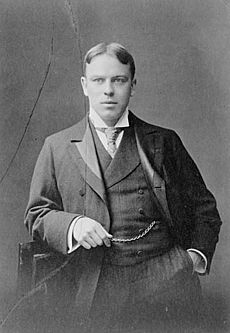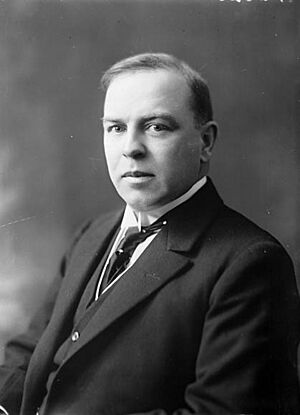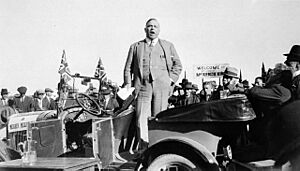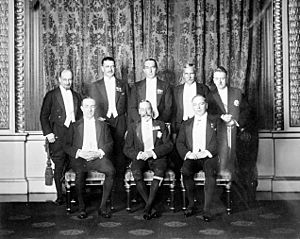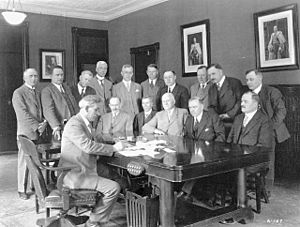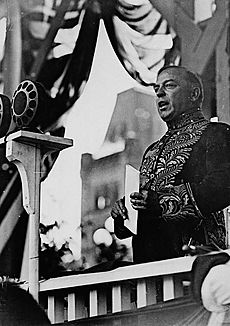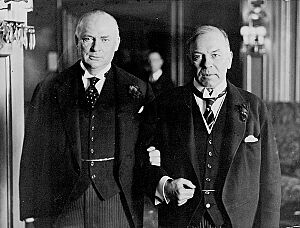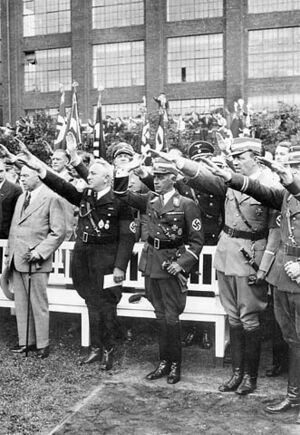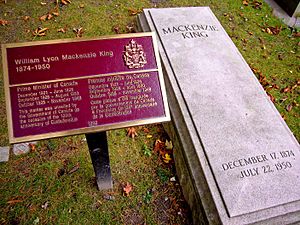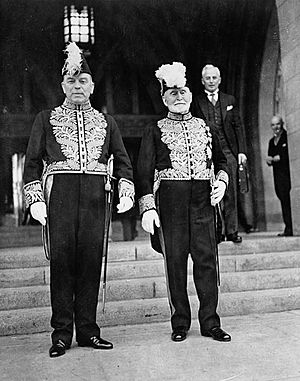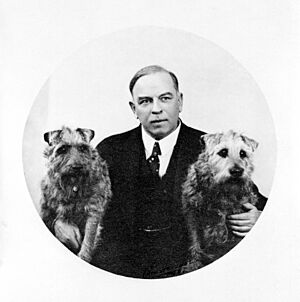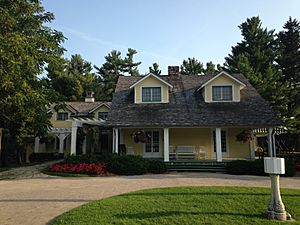William Lyon Mackenzie King facts for kids
Quick facts for kids
William Lyon Mackenzie King
|
|
|---|---|

King in 1947
|
|
| 10th Prime Minister of Canada | |
| In office October 23, 1935 – November 15, 1948 |
|
| Monarch | |
| Governor General |
|
| Preceded by | R. B. Bennett |
| Succeeded by | Louis St. Laurent |
| In office September 25, 1926 – August 7, 1930 |
|
| Monarch | George V |
| Governor General | |
| Preceded by | Arthur Meighen |
| Succeeded by | R. B. Bennett |
| In office December 29, 1921 – June 28, 1926 |
|
| Monarch | George V |
| Governor General | The Lord Byng of Vimy |
| Preceded by | Arthur Meighen |
| Succeeded by | Arthur Meighen |
| Secretary of State for External Affairs | |
| In office October 23, 1935 – September 4, 1946 |
|
| Prime Minister | Himself |
| Preceded by | R. B. Bennett |
| Succeeded by | Louis St. Laurent |
| In office September 25, 1926 – August 7, 1930 |
|
| Prime Minister | Himself |
| Preceded by | Arthur Meighen |
| Succeeded by | R. B. Bennett |
| In office December 29, 1921 – June 28, 1926 |
|
| Prime Minister | Himself |
| Preceded by | Arthur Meighen |
| Succeeded by | Arthur Meighen |
| Leader of the Liberal Party | |
| In office August 7, 1919 – August 7, 1948 |
|
| Preceded by | Daniel Duncan McKenzie (interim) |
| Succeeded by | Louis St. Laurent |
| Minister of Labour | |
| In office June 2, 1909 – October 6, 1911 |
|
| Prime Minister | Wilfrid Laurier |
| Preceded by | Position established |
| Succeeded by | Thomas Wilson Crothers |
| Member of the House of Commons of Canada | |
| In office August 6, 1945 – November 15, 1948 |
|
| In office February 15, 1926 – June 11, 1945 |
|
| In office October 20, 1919 – October 29, 1925 |
|
| In office October 26, 1908 – September 21, 1911 |
|
| Personal details | |
| Born | December 17, 1874 Berlin, Ontario, Canada |
| Died | July 22, 1950 (aged 75) Chelsea, Quebec, Canada |
| Resting place | Mount Pleasant Cemetery, Toronto, Ontario |
| Political party | Liberal |
| Alma mater |
|
| Signature | |
William Lyon Mackenzie King (December 17, 1874 – July 22, 1950) was a Canadian politician who served as the tenth prime minister of Canada. He held this important role for three separate periods: from 1921 to 1926, 1926 to 1930, and 1935 to 1948. As a member of the Liberal Party, he was the most influential politician in Canada from the early 1920s to the late 1940s.
King is especially remembered for leading Canada through two major historical events: the Great Depression and the Second World War. He also helped create Canada's welfare state, which provides support for citizens, and established Canada's reputation as a middle power that works for world peace. With a total of 21 years and 154 days in office, he is the longest-serving prime minister in Canadian history.
Born in Berlin, Ontario (now Kitchener), King studied law and economics in the 1890s. He was very interested in social welfare issues. He later earned a PhD, making him the only Canadian prime minister to have this degree. In 1900, he became a senior official in the new Department of Labour. He entered the House of Commons in 1908 and became the federal Minister of Labour in 1909 under Prime Minister Wilfrid Laurier.
After losing his seat in the 1911 election, King worked for the Rockefeller Foundation. He also worked as a consultant for businesses. When Laurier died in 1919, King became the leader of the Liberal Party. He won a special election to return to the House of Commons. The Liberal Party was divided after the First World War because of the Conscription Crisis of 1917 (forced military service). King managed to unite the different groups within the party. This led the Liberals to victory in the 1921 federal election.
Contents
- Early Life & Education
- Early Career & Politics
- Out of Politics & Return
- Prime Minister: First Terms (1921–1930)
- Opposition Leader (1930–1935)
- Prime Minister: Final Term (1935–1948)
- Retirement and Death
- Personal Style
- Legacy
- Memorials
- Honours
- Honorary Degrees
- Supreme Court Appointments
- See also
Early Life & Education
Growing up in Ontario
William Lyon Mackenzie King was born on December 17, 1874. His family lived in a rented house in Berlin, Ontario (now Kitchener). His parents were John King and Isabel Grace Mackenzie. His grandfather on his mother's side was William Lyon Mackenzie. He was the first mayor of Toronto and a leader of the Upper Canada Rebellion in 1837. King's father was a lawyer and later taught at Osgoode Hall Law School. William had three siblings.
King's family did not always have a lot of money. His father's law practice struggled in their small city. They tried to keep up appearances, even hiring servants and tutors they could barely afford. Their financial situation got a bit better when they moved to Toronto around 1890. King lived with them there for several years while he studied at the University of Toronto.
King was a lifelong Presbyterian. He believed in social reform because of his Christian faith. He never supported socialism.
University Years
King started at the University of Toronto in 1891. He earned a Bachelor of Arts degree in 1895, a Bachelor of Laws degree in 1896, and a Master of Arts in 1897. While studying in Toronto, he met many friends who later became important people. He was part of the Kappa Alpha Society, which encouraged political discussions. He also met Arthur Meighen, who would become a political rival. They did not get along well from the start.
King was very interested in social welfare issues. He was inspired by the settlement house movement, which helped poor communities. He played a key role in a student strike at the university in 1895. He later earned a Master of Arts degree in political economy from Harvard University in 1898. In 1909, Harvard gave him a PhD for his work on industrial problems in Canada. He is the only Canadian Prime Minister with a PhD.
Early Career & Politics
Working for the Government
In 1900, King became the editor of the Labour Gazette. This was a government publication that looked into complex issues about workers. Later that year, he was made deputy minister of Canada's new Department of Labour. He worked on policies related to Japanese immigration and railways. He also helped create the Industrial Disputes Investigations Act (1907). This law aimed to prevent worker strikes by encouraging discussion before conflicts started.
In 1901, King's best friend, Henry Albert Harper, died trying to save a young woman who fell through ice on the Ottawa River. King helped raise money for a memorial to Harper. This led to the Sir Galahad statue on Parliament Hill in 1905. In 1906, King wrote a book about Harper called The Secret of Heroism.
While working as deputy minister, King also investigated the causes of the 1907 anti-Asian riots in Vancouver's Chinatown and Japantown. He also looked into claims for compensation from these events.
First Time as Minister of Labour
King was first elected to Parliament as a Liberal in the 1908 federal election. He represented the area of Waterloo North. In 1909, Prime Minister Wilfrid Laurier appointed King as the first-ever Minister of Labour.
During his time as Minister of Labour, King achieved two important things. He helped pass the Industrial Disputes Investigation Act and the Combines Investigation Act. These laws greatly improved the financial situation for many Canadian workers. In 1910, King also tried to pass a bill for an 8-hour workday on public projects, but it did not pass. He lost his seat in the 1911 general election. In this election, the Conservatives defeated the Liberals and formed the government.
Out of Politics & Return
Working as a Consultant
After his election defeat, King gave speeches for the Liberal Party. In 1914, John D. Rockefeller Jr. hired him to lead a new department at the Rockefeller Foundation in New York City. This job paid much more than what the Liberal Party was paying him. He worked for the Foundation until 1918. He became good friends with Rockefeller and advised him during a difficult period for a family-owned coal company in Colorado. This experience helped shape new ways of managing workers in America. King became an early expert in the field of industrial relations.
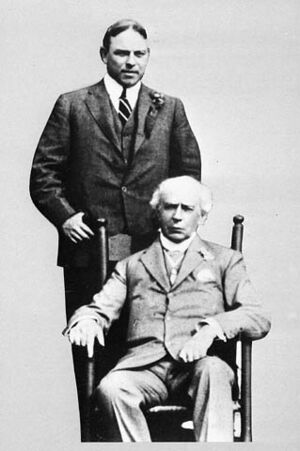
King was not a pacifist, but he was not very enthusiastic about the Great War. He faced criticism for not serving in Canada's military. However, he was almost 40 years old when the war started and was not in good physical shape. He helped the war effort by keeping war-related industries running smoothly.
In 1918, King published a book called Industry and Humanity. In this book, he argued that businesses and workers should be allies, not enemies. He believed the government should help solve industrial disputes. After leaving the Rockefeller Foundation in 1918, King worked as an independent consultant on labour issues for two years. He earned a lot of money, but he kept his home in Ottawa, hoping to return to politics.
Wartime Politics
In 1917, Canada faced a crisis over conscription (forced military service). King supported Liberal leader Wilfrid Laurier, who opposed conscription. The Liberal party was deeply divided. King returned to Canada to run in the 1917 election, which was mostly about conscription. He lost in his constituency, which his grandfather had once represented.
Becoming Opposition Leader
The Liberal Party was very divided after the war. When Laurier died in 1919, King was elected leader at the first Liberal leadership convention. He won thanks to the support of the Quebec group, led by Ernest Lapointe. Lapointe later became King's long-time helper in Quebec. King could not speak French, but Lapointe helped the Liberals win many elections in Quebec for the next 20 years.
Once King became the Liberal leader, he paid more attention to the Prairies. This was a fast-growing region. He saw it as a place for a "New Social Order." He also knew his party needed the votes of Progressive Party Members of Parliament, who represented farmers. He convinced many Progressives to rejoin the Liberal Party.
In the 1921 election, King's Liberals defeated the Conservatives. They won a small majority of 118 out of 235 seats. The newly formed Progressive Party won 58 seats. King became prime minister.
Prime Minister: First Terms (1921–1930)
Balancing Different Needs
During his first time as prime minister (1921 to 1926), King wanted to lower wartime taxes. He also aimed to reduce ethnic and labour tensions from the war. He believed it would take a long time to heal the wounds the war had caused.
King could not get the Progressives to join his government. However, he relied on their support in Parliament to defeat motions from the Conservatives. King had to be careful. He needed to lower tariffs (taxes on imported goods) enough to please the Prairie-based Progressives. But he also needed to keep the support of industrial areas in Ontario and Quebec, who thought tariffs were important to compete with American goods.
Over time, the Progressives became weaker. Their leader, Thomas Crerar, resigned. King was able to work with other Progressive members, and some even joined his cabinet.
Immigration Policies
In 1923, King's government passed the Chinese Immigration Act, 1923. This law banned most Chinese immigration to Canada. While immigration from most countries was controlled, only Chinese people were completely stopped from immigrating. This happened after federal and provincial governments, especially British Columbia, pushed for it.
Also in 1923, the government changed the Immigration Act. This allowed people from Austria-Hungary to enter Canada again. Ukrainian immigration, which had been restricted during World War I, was able to restart.
Developing Canada's Capital
King was always interested in city planning, especially for Ottawa, Canada's capital. He saw city planning as part of his larger goal of social reform. His biggest impact was on the planning of Ottawa. His ideas, many of which were completed after his death, helped make Ottawa a national space with beautiful designs. For example, Confederation Square was planned as a civic area. The Great War monument was installed there in 1939. King wanted the replanning of the capital to be a memorial for World War I.
The King–Byng Affair
In June 1926, King faced a vote in the House of Commons that could force his government to resign. He asked the Governor General, Lord Byng, to dissolve Parliament and call a new election. Lord Byng refused King's request. This was the first time in Canadian history a Governor General refused a Prime Minister's request to dissolve Parliament.
Instead, Byng asked Opposition Leader Arthur Meighen to form a government. The Conservatives had more seats, but not a majority. They soon lost a motion of no confidence themselves. Meighen then asked Byng to dissolve Parliament, which Byng agreed to.
King campaigned in the 1926 election on the idea that Canadians had the right to govern themselves. He spoke against the interference of the Crown. The Liberal Party won the election with a minority government. This strengthened King's position and the role of the Prime Minister. King then pushed for Canada to have more independence in foreign policy at the 1926 Imperial Conference. This led to the Balfour Declaration. It stated that Canada and other dominions were autonomous communities within the British Empire. They were no longer controlled by the United Kingdom. This was later made official in the Statute of Westminster 1931.
Canada's Growing Independence
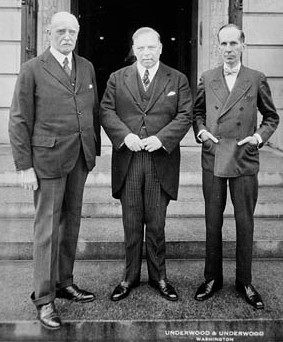
During the Chanak Crisis in 1922, King refused to support Britain without first asking the Canadian Parliament. He wanted Canada to have its own voice in foreign affairs, separate from London. King told the British Prime Minister that Canada's Parliament would decide its policy. He made it clear Canada would not be forced into European wars.
For years, halibut fish stocks were decreasing in Canadian and American waters. In 1923, King's government negotiated the Halibut Treaty with the United States. This treaty banned commercial fishing for halibut during certain months. What was special about this agreement was that Canada negotiated it without a British delegate present. King argued that the situation only concerned Canada and the United States. After this, the British accepted King's plan to send a separate Canadian diplomat to Washington D.C. to represent Canada's interests.
King expanded the Department of External Affairs, which was created in 1909. This helped Canada become more independent from Britain. The new department grew over time and greatly increased Canada's diplomatic reach. Before this, Canada relied on British diplomats. King hired many talented people for this new department, including future prime minister Lester Pearson. This project was a key part of King's plan to make Canada independent from Britain, France, and the powerful United States.
Throughout his time in office, King helped Canada change from a dominion under British rule to an independent nation within the British Commonwealth. King pushed for Canadian independence against British attempts to make the Commonwealth an alliance.
Other Reforms
In Canada, King strengthened the Liberal policy of giving more power to provincial governments. He gave the provinces of Manitoba, Alberta, and Saskatchewan ownership of the crown lands and underground resources within their borders. These resources, especially oil, became very important. Working with the provinces, he started a system of old-age pensions for those in need. In February 1930, he appointed Cairine Wilson as the first female senator in Canadian history.
Taxes were reduced, including sales tax exemptions and larger income tax exemptions. In 1929, taxes on cables, telegrams, and train and ship tickets were removed.
Measures were also put in place to help farmers. For example, in 1922, a law was passed to restore railway rates for grain and flour moving east from the prairie provinces. A Farm Loan Board was set up to provide loans to farmers. Other measures included preventing animal diseases and setting quality standards for farm products. The Combines Investigation Act of 1923 aimed to protect consumers and producers from unfair practices. A Fair Wages and Eight Hours Day Act was introduced in 1930.
Defeat in 1930
King's government was in power when the Great Depression began. However, they were slow to react to the growing crisis. King believed the crisis was a temporary economic downturn and that the economy would recover on its own. Critics said he was out of touch. Just before the election, King famously said he "would not give a five-cent piece" to Conservative provincial governments for unemployment relief. This remark became a popular slogan for the opposition. The main issue was the worsening economy and whether the prime minister understood the struggles of ordinary people.
The Liberals lost the election of 1930 to the Conservative Party, led by Richard Bedford Bennett. The popular vote was very close, but the Conservatives won enough seats to form a majority government.
Opposition Leader (1930–1935)
After his loss, King remained the leader of the Liberals. He became the Leader of the Opposition for the second time. King believed his government did not deserve to lose and that their careful financial policies had helped the economy. He blamed the crisis on business speculation and weather patterns. King argued that the worst thing Canada could do was raise tariffs and limit international trade. He thought voters would eventually realize they had been misled by Bennett and appreciate his government's focus on saving money and free trade.
King's strategy was not to offer much advice or different policies. His ideas were not very different from Bennett's, so he let the Conservative government try to solve the problems. Although he seemed to support progressive ideas, he was not enthusiastic about the New Deal in the United States. He never pushed for massive government action to fix the Depression in Canada.
As Opposition leader, King criticized Bennett's government for its budget deficits. However, he did not suggest his own ways to balance the budget. King also criticized the "blank cheques" Parliament was asked to approve for relief. He delayed these bills, even though some Liberals worried the public might think they didn't care about struggling people. Each year, King introduced changes that blamed the Depression on Bennett's high tariffs.
By the time the 1935 election came, Bennett's government was very unpopular because of how they handled the Depression. Using the slogan "King or Chaos," the Liberals won a huge victory. They won 173 out of 245 seats, giving them the largest majority government at the time. The Conservatives were reduced to only 40 seats.
Prime Minister: Final Term (1935–1948)
For the first time, King led a strong Liberal majority government. When he returned to office in October 1935, he seemed committed to helping those in need. He spoke of a new era where "poverty and adversity, want and misery are the enemies which liberalism will seek to banish from the land." King again appointed himself as Secretary of State for External Affairs. He held this position until 1946.
Economic Changes
Free Trade
King's government promised a trade agreement with the U.S. They passed the 1935 Reciprocal Trade Agreement. This was a major turning point in Canadian-American economic relations. It reversed a difficult trade war from 1930–31, lowered tariffs, and greatly increased trade. It also showed King and President Roosevelt that they could work well together.
Social Programs
King's government created the National Employment Commission in 1936. King was not keen on federal relief for the unemployed. However, the first national unemployment insurance program was started in August 1940. This happened after all Canadian provinces agreed to change the constitution to give the federal government power over unemployment insurance.
Over the next 13 years, many reforms similar to the American New Deal happened under King. In 1937, the age for blind people to get old-age pensions was lowered to 40, and later to 21 in 1947. In 1939, compulsory contributions for pensions for low-income widows and orphans were introduced. Farmers also received subsidies from that year. In 1944, family allowances were introduced. This was Canada's first universal welfare program. From 1948, the federal government also helped fund medical services in the provinces.
Managing Spending
Provincial governments faced less income and higher welfare costs. They needed federal money to reduce their deficits. In December 1935, King announced that federal grants would increase until spring 1936. At first, King wanted each level of government to pay for its programs using its own taxes.
King slowly accepted a Keynesian approach. This involved federal deficit spending (spending more than collected in taxes), tax cuts, and help for the housing market. King and his finance minister, Charles Avery Dunning, had planned to balance the budget for 1938. However, some colleagues wanted to create jobs to boost the economy. They used the ideas of British economist John Maynard Keynes. King accepted their arguments and ran deficits in 1938 and 1939.
Workers' Rights
Provinces received help from the Federal Unemployment and Agricultural Assistance Act of 1938 and the Youth Training Act of 1939. These acts created training programs for young people. An amendment to the Criminal Code in May 1939 made it illegal to refuse to hire or fire someone just because they belonged to a legal trade union.
The Vocational Training Co-ordination Act of 1942 encouraged provinces to set up post-secondary vocational training. In 1948, the Industrial Relations and Disputes Investigation Act was passed. This law protected workers' rights to join unions and required employers to recognize unions chosen by their employees.
Housing
The Federal Home Improvement Plan of 1937 offered lower interest rates on loans to fix up homes. The National Housing Act of 1938 provided for building low-rent housing. Another Housing Act was passed in 1944. Its goal was to provide federally guaranteed loans or mortgages for people who wanted to repair or build homes themselves.
Agriculture
King had opposed Bennett's Canadian Wheat Board in 1935, but he accepted its operation. By 1938, the board had sold its holdings, and King suggested returning to an open market. This angered Western Canadian farmers, who wanted a board that would guarantee them a minimum price. Facing public pressure, King and his Minister of Agriculture, James Garfield Gardiner, reluctantly kept the board and offered a minimum price to protect farmers from further price drops.
Crown Corporations
In 1937, King's government created Trans-Canada Air Lines (which later became Air Canada). It was a part of the crown corporation, Canadian National Railways. It was made to provide air service to all parts of Canada.
In 1938, King's government made the Bank of Canada a crown corporation, meaning it was owned by the government.
Media Changes
In 1936, the Canadian Radio Broadcasting Commission (CRBC) became the Canadian Broadcasting Corporation (CBC). The CBC was a crown corporation with a better structure and more secure funding. It was also less open to political pressure.
In 1938, King's government invited British filmmaker John Grierson to study government film production. King believed that Canadian cinema should have a bigger presence in Canadian theatres. This led to the National Film Act, which created the National Film Board of Canada in 1939. It was created to make and share films that served the national interest. Its goal was to make Canada better known both at home and around the world.
Relationship with Provinces
After 1936, King became less patient when Western Canadians preferred other political parties like the CCF (Co-operative Commonwealth Federation) and Social Credit. He focused more on the industrial regions and the needs of Ontario and Quebec. This included the proposed St. Lawrence Seaway project with the United States.
In 1937, Maurice Duplessis, the premier of Quebec, passed the Padlock Law. This law threatened to close the offices of labour leaders for any suspected communist activities. King's government considered stopping this law. However, King's cabinet minister, Ernest Lapointe, believed it would hurt the Liberal Party's chances in Quebec. King and his English-Canadian ministers agreed.
Germany and Hitler
In March 1936, when Germany began to re-arm the Rhineland, King told the British government that Canada would remain neutral if Britain went to war with Germany over this issue. In June 1937, King told British Prime Minister Neville Chamberlain that Canada would only go to war if Britain was directly attacked. He said Chamberlain should not expect Canadian support for a war on the European continent.
In 1937, King visited Nazi Germany and met with Adolf Hitler. King had some unusual personal beliefs that he kept private. He thought Hitler was like a mythical hero who was struggling between good and evil. He believed good would win and Hitler would lead his people to a peaceful future. King wrote in his diary that Hitler "is really one who truly loves his fellow-men, and his country, and would make any sacrifice for their good".
In late 1938, during the crisis over Czechoslovakia that led to the Munich Agreement, Canadians were divided. French Canadians wanted to stay neutral. King, who was also his own foreign minister, privately said he would not be neutral if he had to choose. But he made no public statement. All of Canada was relieved when the agreement seemed to bring peace, even though it meant sacrificing Czechoslovakia's rights.
Under King's government, Canada refused to allow more Jewish refugees from Europe to immigrate. This was due to strong public opinion and lobbying from the Catholic Church in Quebec. In June 1939, Canada, along with Cuba and the United States, refused entry to 900 Jewish refugees aboard the ship MS St. Louis.
Second World War
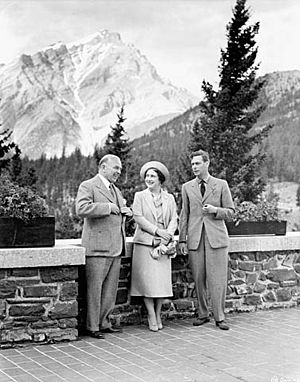
King traveled with King George VI and Queen Elizabeth during their 1939 tour across Canada and to the United States. This was just a few months before World War II began.
Declaring War
King began preparing Canada for war on August 25, 1939. Full preparations started on September 1, 1939, the day Germany invaded Poland. In 1914, Canada was automatically at war when Britain declared it. In 1939, King wanted Canada to make its own decision. He called the House of Commons to discuss entering the war. King said that the Canadian Parliament would make the final decision. He promised pro-British Canadians that Parliament would support Britain. He also promised those who were wary of British influence that Canada would not join British colonial wars. His Quebec helper, Ernest Lapointe, promised French Canadians that there would be no conscription for overseas service. These promises helped Parliament almost unanimously agree to declare war on September 9. On September 10, King asked King George VI, as King of Canada, to declare Canada at war against Germany.
Foreign Policy
To re-arm Canada, King built the Royal Canadian Air Force. He kept it separate from Britain's Royal Air Force. He helped create the British Commonwealth Air Training Plan Agreement. This agreement, signed in Ottawa in December 1939, trained half the airmen from Canada, Britain, New Zealand, and Australia during World War II.
King brought Canada closer to the United States. He signed an agreement with President Roosevelt in August 1940. This agreement allowed Canadian and American forces to work closely together. This happened even though the U.S. was officially neutral until the bombing of Pearl Harbor in December 1941. During the war, the Americans took control of the Yukon to build the Alaska Highway. They also built major airbases in Newfoundland, which was under British rule at the time.

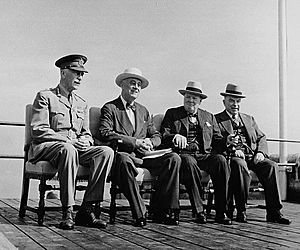

British Prime Minister Winston Churchill largely ignored King and Canada. This was despite Canada's big role in providing food, raw materials, weapons, and money to Britain. Canada also trained airmen for the Commonwealth and guarded the western North Atlantic Ocean against German U-boats. Canadian troops also fought in Italy, France, and Germany from 1943–45. King was very successful at getting Canada's economy ready for war. This led to impressive increases in industrial and agricultural production. The Depression ended, prosperity returned, and Canada's economy grew a lot.
During the war, Canada quickly opened more diplomatic offices in other countries. Canada hosted two major Allied conferences in Quebec in 1943 and 1944. However, King and his top military leaders were not invited to take part in the discussions.
Political Affairs
King's government took a strong step in the 1939 Quebec general election. They worked to defeat Quebec Premier Maurice Duplessis's Union Nationale party, which was against the war. They wanted the pro-war Quebec Liberals to win. Three of King's cabinet ministers from Quebec threatened to resign if Duplessis won. They said no one would be left to represent Quebec in the Cabinet if conscription became an issue again. King believed Duplessis wanted to cause a crisis between French Canada and English Canada. King used his powers under the War Measures Act to stop Duplessis from speaking on the radio. The Quebec Liberals won a huge victory.
King did not want a government of national unity like during World War I. When the Legislative Assembly of Ontario criticized King's government for not fighting the war strongly enough, King dissolved Parliament. This led to a federal election on March 26, 1940. He held the election despite the ongoing war, unlike Britain. King won another huge victory, winning 179 seats. This was the Liberals' most successful result at the time.
Wartime Spending
On June 24, 1940, King's government presented Canada's first $1 billion budget. It included $700 million for war expenses. This was much more than the $126 million spent in the 1939–1940 fiscal year. However, because of the war, the overall economy was the strongest in Canadian history.
Internment of Japanese-Canadians
After the attack on Pearl Harbor in December 1941, Japanese Canadians were seen as enemy aliens under the War Measures Act. This law began to take away their personal rights. Starting on December 8, 1941, 1,200 Japanese-Canadian-owned fishing boats were seized. On January 14, 1942, the government ordered the removal of Japanese men aged 18 to 45 from a protected area 100 miles inland from the British Columbia coast. They also banned Japanese-Canadian fishing during the war and controlled the sale of gasoline and dynamite to Japanese Canadians.
Three weeks later, on February 19, 1942, US President Franklin D. Roosevelt signed an order to remove 110,000 people of Japanese background from the American coastline. This action influenced the fate of Japanese Canadians. On February 24, the Canadian government passed an order allowing the removal of "all persons of Japanese origin". This order allowed the Minister of Justice to remove people from any protected area in Canada, especially Japanese Canadians on the Pacific coast. On February 25, the government announced that Japanese Canadians were being moved for national security reasons. In total, about 27,000 people were held without charges or trials, and their property was taken. Some were even sent to Japan.
King and his Cabinet received different reports about the potential threat from the Japanese. Some military officials said Japanese Canadians were not a threat. Others, including local law enforcement, believed there was a serious danger.
Scientific Research
King's government greatly expanded the role of the National Research Council of Canada during the war. They moved into full-scale research in nuclear physics and the commercial use of nuclear power in the years that followed. King, with C. D. Howe leading the effort, moved the nuclear group from Montreal to Chalk River, Ontario in 1944. This led to the creation of Chalk River Nuclear Laboratories. Canada became a world leader in this field. The NRX reactor became operational in 1947. At that time, NRX was the only working nuclear reactor outside the United States.
Conscription
King's promise not to force military service helped the Liberals win the 1939 Quebec provincial election and the 1940 federal election. But after France fell in 1940, Canada introduced conscription for service within Canada only. Only volunteers were to be sent overseas. King wanted to avoid a repeat of the Conscription Crisis of 1917. By 1942, the military strongly urged King to send conscripts to Europe. In 1942, King held a national vote asking the country to release him from his election promise. On June 10, 1942, he said his policy was "not necessarily conscription but conscription if necessary".
French Canadians voted against conscription, with over 70 percent opposed. However, an overwhelming majority – over 80 percent – of English Canadians supported it. French and English conscripts were sent to fight in the Aleutian Islands in 1943. This was technically North American soil, so it was not "overseas." King continued to recruit volunteers. In November 1944, the government decided it was necessary to send conscripts for the war. This led to a brief political crisis and a mutiny by conscripts in British Columbia. However, the war ended a few months later. In total, 12,908 conscripts were sent to fight abroad, but only 2,463 saw combat.
Post-War Canada
1945 Election
As the war was ending, King called a federal election for June 11, 1945. The Liberals' campaign focused on a broad program of social security. King was hesitant to expand government's role and run deficits. However, he accepted these measures because they helped people struggling financially. There were also political reasons. The Liberals needed to compete with the growing socialist Co-operative Commonwealth Federation (CCF) for votes.
The Liberals lost their huge majority government and became a minority government. However, they could still govern with the support of eight "Independent Liberal" MPs. These MPs did not run as official Liberals because they opposed conscription. The Liberals' drop in support was partly due to the introduction of conscription, which was unpopular in many parts of Canada. King lost his own riding (electoral district). Another Liberal MP resigned so King could run in a special election, which King won.
Foreign Affairs & Cold War
King helped create the United Nations (UN) in 1945 and attended its first meetings. He believed that middle powers like Canada should have influence in the UN. This was based on their contributions to solving disputes.
King moved Canada into the growing Cold War alongside the U.S. and Britain. He handled the spy revelations from Soviet clerk Igor Gouzenko. Gouzenko defected in Ottawa in September 1945. King quickly appointed a Royal Commission to investigate Gouzenko's claims of a Canadian Communist spy-ring sending secret documents to Moscow. Justice Minister Louis St. Laurent dealt with this crisis, the first of its kind in Canada. St. Laurent later became King's external affairs minister in September 1946.
Domestic Achievements
After the war, King quickly removed wartime controls. Unlike World War I, press censorship ended when the fighting stopped.
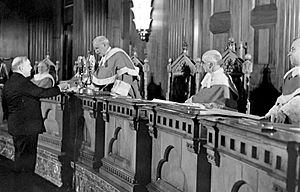
King's government introduced the Canadian Citizenship Act in 1946. This law officially created the idea of "Canadian citizens". Before this, Canadians were considered British subjects living in Canada. On January 3, 1947, King received Canadian citizenship certificate number 0001.
King also prepared the way for Newfoundland to join Canadian Confederation. He said, "Newfoundlanders are no strangers to Canada, nor are Canadians strangers to Newfoundland." Pro-Confederation Newfoundlanders argued that joining Canada would improve their standard of living. Britain also supported Confederation. A second vote was held on July 22, 1948. 52.3 percent of voters decided that Newfoundland should join Canada. After this, Newfoundland joined Confederation on March 31, 1949, becoming Canada's tenth province.
Retirement
King's health was declining. In May 1948, he announced he would not be the Liberal leader in the next election. On August 7, 1948, the Liberal Party chose Louis St. Laurent as their new leader. St. Laurent was King's personal choice. Three months later, on November 15, King retired after 21 and a half years as prime minister. King was the longest-serving prime minister in Canadian history. He also served in the most parliaments as prime minister.
Retirement and Death
King had plans to write his memoirs. However, he did not have a long retirement. He died on July 22, 1950, at his country estate in Kingsmere from pneumonia. He is buried in Mount Pleasant Cemetery, Toronto.
Personal Style
King was not a charismatic speaker and did not have a strong presence. He was not good on the radio or in newsreels. He was often cold and lacked tact in his relationships with people. He had many political allies but very few close personal friends.
Historians believe King's long time as party leader was due to his many skills. These skills were well-suited to Canada's needs at the time. King kept a very detailed diary from 1893 until a few days before his death in 1950. These diaries are very important historical documents. They help explain Canada's actions during World War II and describe other events in detail.
King's unusual personal interests were kept secret while he was in office. They only became public after his death when his diaries were opened. Some historians say he sought personal comfort from these interests, rather than political advice. Historians have debated whether his beliefs influenced his political decisions.
King never married. He had several close female friends, including Joan Patteson, a married woman with whom he spent some of his free time. She sometimes hosted his dinner parties. He felt the lack of a wife to handle the many social duties of a prime minister.
Legacy
Historian George Stanley argues that King's wartime policies were effective and successful. This is why his government continued to have public support after World War II, unlike many other wartime governments. Historian Jack Granatstein notes that Canada's economic management during the war was considered the most successful among all the countries involved.
Historian Christopher Moore says that King often used the phrase "Parliament will decide" to avoid making difficult decisions himself. King was very sensitive to public policy and had a deep understanding of Canada's complex society. His strength was in bringing people together, building support, and passing laws that had wide national agreement. Advances in the welfare state are an example of this. His successors continued to build on the welfare state he started during World War II.
Historian H. Blair Neatby wrote that King continues to interest Canadians. Critics say he stayed in power by avoiding decisions and not providing creative leadership. His supporters argue that he slowly changed Canada, a difficult country to govern, while keeping the nation united.
King was ranked among the top three Canadian Prime Ministers by a survey of Canadian historians. He was named a Person of National Historic Significance in 1968.
Memorials
King's picture has been on the Canadian fifty-dollar note since 1975.
King did not publish political memoirs, but his private diaries are very detailed. His main published work is his 1918 book Industry and Humanity.
After King's diaries were published in the 1970s, several fictional works about him were written by Canadian authors. These included Elizabeth Gourlay's novel Isabel and Allan Stratton's play Rexy.
In 1998, there was a disagreement about King being left out of a memorial for the Quebec Conference. King, Roosevelt, and Churchill attended this conference. The monument was ordered by the sovereigntist Parti Québécois government of Quebec. They said King was only acting as a host for the meeting between Roosevelt and Churchill. However, Canadian federalists accused the Quebec government of trying to push their own political agenda.
The OC Transpo Transitway station is named Mackenzie King because of its location on the Mackenzie King Bridge. It is near the Rideau Centre in downtown Ottawa.
The bridge across the Rideau Canal in downtown Ottawa, built after World War II, is named in his honour. This recognizes his contributions to planning the city of Ottawa.
King left his private country retreat in Kingsmere, Quebec, near Ottawa, to the Government of Canada. Most of the estate became part of the federally managed Gatineau Park. King's summer home at Kingsmere, called "The Farm," is now the official residence of the Speaker of the House of Commons of Canada. The Farm and its grounds are in Gatineau Park but are not open to the public.
The Woodside National Historic Site in Kitchener, Ontario was King's childhood home. The estate has over 4.65 hectares of garden and parkland. The house has been restored to show what life was like during King's time. There is also a MacKenzie King Public School in Kitchener.
King was mentioned in the children's book Alligator Pie by Dennis Lee. A silly poem in the book reads: "William Lyon Mackenzie King / He sat in the middle and played with string / He loved his mother like anything / William Lyon Mackenzie King."
King is a character in Donald Jack's novel Me Too, which is set in Ottawa in the 1920s.
A character named "Mackenzie King" appeared twice in the popular 1990s Canadian television series Due South.
King is played by Sean McCann in Donald Brittain's 1988 television miniseries The King Chronicle. He is also played by Dan Beirne in Matthew Rankin's 2019 film The Twentieth Century.
Honours
| Ribbon | Description | Notes |
|---|---|---|
| Order of Merit (OM) |
|
|
| Companion of the Order of St Michael and St George (CMG) | ||
| King George V Silver Jubilee Medal |
|
|
| King George VI Coronation Medal |
|
|
| Grand Croix de l'Ordre national de la Légion d'honneur | ||
| Grand croix de l'Ordre de la couronne de Chêne | ||
| Grand cordon de l'Ordre de Léopold |
Honorary Degrees
| Location | Date | School | Degree |
|---|---|---|---|
| 1919 | Queen's University | Doctor of Laws (LL.D) | |
| 1923 | University of Toronto | Doctor of Laws (LL.D) | |
| 1924 | Yale University | Doctor of Laws (LL.D) | |
| 1948 | College of William and Mary | Doctor of Laws (LL.D) | |
| 3 June 1950 | University of Western Ontario | Doctor of Laws (LL.D) |
Supreme Court Appointments
King chose the following judges to be appointed as justices of the Supreme Court of Canada:
- Arthur Cyrille Albert Malouin (January 30, 1924 – October 1, 1924)
- Francis Alexander Anglin (as Chief Justice, September 16, 1924 – February 28, 1933; appointed a Puisne Justice under Prime Minister Laurier, February 23, 1909)
- Edmund Leslie Newcombe (September 16, 1924 – December 9, 1931)
- Thibaudeau Rinfret (October 1, 1924 – June 22, 1954; appointed as Chief Justice January 8, 1944)
- John Henderson Lamont (April 2, 1927 – March 10, 1936)
- Robert Smith (May 18, 1927 – December 7, 1933)
- Lawrence Arthur Dumoulin Cannon (January 14, 1930 – December 25, 1939)
- Albert Blellock Hudson (March 24, 1936 – January 6, 1947)
- Robert Taschereau (February 9, 1940 – September 1, 1967)
- Ivan Rand (April 22, 1943 – April 27, 1959)
- Roy Lindsay Kellock (October 3, 1944 – January 15, 1958)
- James Wilfred Estey (October 6, 1944 – January 22, 1956)
- Charles Holland Locke (June 3, 1947 – September 16, 1962)
|
See also
 In Spanish: William Lyon Mackenzie King para niños
In Spanish: William Lyon Mackenzie King para niños


